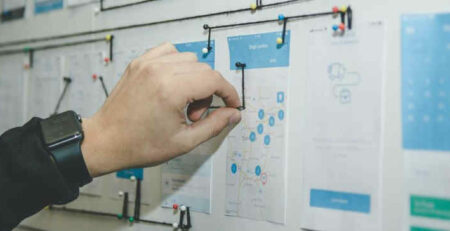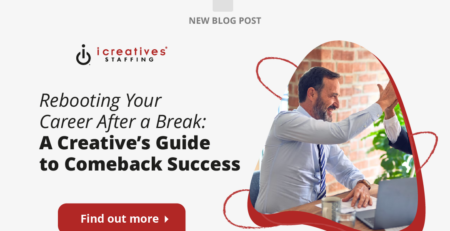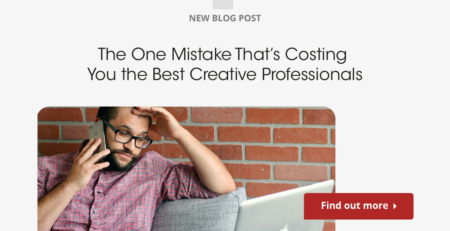A Beginner’s Guide to UX Design Research
To craft the best user experience, designers have to fully understand the people who use the final product. Exhaustive research is done throughout the design process so that the creatives behind the product understand how people discover and handle each aspect of the design.
UX design research comes in many forms. Since the design process is iterative, testing has to be done repeatedly to identify problems and see how effective certain aspects of the design are.
One of the first stages of designing is working with stakeholders to make sure business goals are met. Whether you’re a non-creative stakeholder or a creative adjacent to UX designers, you can read this guide to get a full picture of UX design research and its primary aims.
What Is UX Design Research?
Users have unique attitudes, behavior, and desires. Discovering these three things is essential to a successful design. Observation is central to many of these design research methods, but it isn’t the only way to find out information about people.
One of the best ways to find out what people need out of a product is to give them a prototype to test. After the information has been collected, it has to be summarized and organized to inform the design process.
The format of user research takes various shapes and structures. Interviews, prototype tests, surveys, and review of existing literature and data are all part of the process. While the research doesn’t necessarily have a fixed order from project to project, the goals of the research change as the design matures.
In the beginning, the research aims to discover the needs and desires of users and the central goals of stakeholders. As the product begins to take shape, research narrows its scope to the specific reaction and opinion of users who test the design.
Goals of UX Design Research
So, what is all this user research supposed to reveal? UX designers perform research to find out how they can impact their users in the following ways:
- Duration
Appealing designs should hold users’ attention for as long as it takes to get them to a call to action. The goals of the product will affect how long the user should be engaged. For example, a streaming platform likely wants users to be comfortable and immersed in the product for hours-long durations while an eCommerce site may want a more streamlined experience.
Measuring the duration includes observing the initial engagement, degree of immersion, the conclusion of the experience, and the likelihood of return use.

- Intensity
How pleasing was the overall experience and did it command the full attention of the user? Both of these categories are included in the intensity category.
UX designers also look at the habits of users when they use the site and whether or not the design becomes their go-to tool for solving particular problems. Building a design that is truly pleasing for the user typically involves making the design “invisible,” i.e. making it so effective that the user hardly notices it’s there.
- Breadth
The number of functions on a given product is referred to as “ functional width” by UX designers. The network of more specific support functions is called functional depth. This has to with the structure of the product, names, and a link between other products by the same company.
Building a wide breadth is necessary for some projects, while others have very simple designs and key options set out clearly. For large designs, it’s important to establish the functional width of the design before concentrating on the depth of any single function. Designs that aim to spotlight one or several particular functions can establish the depth of these functions and the build out wider later on.
- Interaction
Users can come into contact and move through a design in a few different ways, generally speaking. They can be active designs, meaning they require lots of direct input from the user. Passive UX design requires less interaction.
Most social media sites are great examples of active UX design. The users have to input information to make posts, like pages, share videos, etc. Cloud file storage is a much more passive UX design because the user only has to add a file and then they can leave the site until it’s needed again.
- Triggers
UX design is highly influenced by psychology. Triggers are a great example of this. Any aspect of a product that catches the user’s attention and holds onto it is a trigger.
There are principles to guide designers when they’re building triggers into their designs. Reciprocity, or the idea that we should return respect and service when it’s given to us, is a key idea in many designs. The product gives something to the user up-front so that they are more likely to engage with a call to action like a registration or purchase button.
- Significance
For users to enjoy their experience and make it more likely that they’ll use the product or service again, the interaction should be meaningful. Even if you’re not changing their entire life, the design should create an emotional connection with the user that they won’t soon forget.
Any positive emotion can produce this effect. Happiness, satisfaction, and humor all increase overall enjoyment and should be the goal of UX designers. The function of the service should be clear and the process of use should be intuitive.
Types of UX Design Research
User research includes many methods beyond outright product testing. Designers also perform ethnographic field studies, focus groups, interviews, and various types of surveys.
You could divide these various design research methods into two camps: behavioral and attitudinal. To measure behavior, you need to have a prototype or some kind of product for the user to try out. Attitudinal studies discuss ideas more broadly and are generally used in the first part of the design process.
Focus groups and interviews are classic examples of opinion research. Designers want to understand the problems users experience – which are called “pain points.” Behavioral studies are exemplified by A/B testing, usability testing, eye tracking, and true intent studies.
8 Methods For Behavioral & Attitudinal User Research
Work with a prototype or a small part of the actual design is what most people think of first when they think of UX or design research. It’s the best way to see how the product works and avoid limitations caused by bias on the creative team. Let the people who will wind up using the product test it out and see how it works.
People say lots of things that aren’t completely accurate, even when they’re describing their own behavior and what they want out of a product. Behavioral research eliminates this skewed information by allowing designers to see how the users actually behave. A few of the most common design research methods are listed below.
- A/B Testing
In this variety of UX research, participants are given variations of a design and asked which they prefer. Designers would be wasting a ton of time if they made two fully thought out designs just to eliminate one when users didn’t prefer it. Rather, in A/B testing, individual elements are tested.
They might be as small as button designs or a menu layout. The user may not get a look at the whole width and depth of the final product.
- Usability Testing
Users might be brought in for a scripted test of the design or they could be studied in a more natural situation. Scripted studies reveal more quantitative information about specific aspects of the product while natural studies provide more general behavioral information.
In early stages of a project, concept-testing methods are used to illustrate the intended function of the final product with elements that may not be part of the final design. This tells the creatives working on the project whether there is any interest in the product. Later on, more concrete scripted usability testing is used to hone in on smaller details in the design.
- Diary/Camera Studies
To get a better sense of how people use the product in a natural environment, participants are sometimes given a camera or similar method of recording information and impressions about a design or about parts of their lives that are adjacent to the product.
The information gathered with these diary studies is invaluable to UX designers, although it is limited to things the participants are able to and comfortable with saying into a camera. You have to rely on what they say during these testimonials, so it’s best to balance that with some quantitative information from a different design research method.
- Eyetracking
A biometric test, eyetracking is a great way to record what people look at and concentrate on when they’re using a product. UX designers discover users’ real behavior with this method. If you’re trying to build triggers into your design, eyetracking is a good way to see if it works.
What we look at is only part of the way we use a product. The objects we engage with, through clicking for example, are equally as important. But for aspects of the interface and other graphic parts of the design, eyetracking is essential.
- Clickstream Analysis
Similar to eyetracking, clickstream analysis records what users are clicking on. For webpage and app development, this design research method is the fastest way to see what people are actually finding useful in the design. You can also see potential problems illustrated by a lack of clicks or determine which triggers are most effective by recording what the user clicks on first.
Designers study the way users navigate through a design in both scripted and unscripted situations. Setting up the telemetry data collection necessary for clickstream analysis prohibits completely unscripted studies since monitoring clicks without consent is rightly seen as an invasion of privacy.
- Card Sorting
One of the simplest types of UX design research is card sorting. Participants are tasked with organizing items into groups and then categorizing the groups. It might seem overly simple, but it helps designers begin to build the information architecture of the design.
Card sorting is a great way to see how people think. This is essential for information architecture, which is the skeleton of the website or app. Think of information architecture as a map of the site which users can navigate with specific UI elements like buttons.
- Participatory Design
Participants are given design elements and asked to construct their own model of what they think the experience should be like. This is a more inventive way to give the users control over what they can express and generally leads to more creative results.
While other methods also reveal behavioral preferences of the user, this one in particular allows the user to rank what is most important to them and why.
- Ethnographic/Field Study
Seeing how users behave in a natural environment is key to understanding what they truly want, in addition to what they say they want. That’s why ethnographic studies are essential for UX designers.
Again, it’s difficult to see users authentically engaging with a product as if you weren’t there. A field study or ethnographic research does give a good idea of their behavior and pain points, though. This method is generally more effective at generating useful data than focus groups.
5 Steps of UX Design Research
Although the exact process of completing, compiling, and employing user research will differ from project to project, there are 5 general steps most creative teams use:
1- Set Goals
What do you already know about the user and what still remains to be seen? Planning allows UX design teams to decide which research methods they’ll be using and allows them to measure progress.
2- Hypothesize
Make an educated guess about what you’ll find out through the research. It’s perfectly fine to be a bit off the mark with the hypothesis, but it helps concentrate efforts and gauge expectations to make one.
3- Select a Method
Based on what has been hypothesized and what’s already known, which method will glean the most useful information? Perhaps a combination of methods is the best way to get balanced results with as little bias as possible.
4- Do Your Research
Time to meet with users and conduct all necessary testing. Make sure to record everything you can so that the UX designer(s) have plenty to work with down the line.
5- Compile Results
Organize all the new information from the research into an easily accessible format so the designer(s) can parse through it and reference back to it throughout the design process. Stakeholders will also likely want to see a rundown of the results. One of the most common ways for UX designers to compile their research is via personas, which are “users” created to mirror the findings from the research.
What is the Value of UX Research?
For stakeholders and designers alike, a central goal of user research is to remove uncertainty. The product will better serve the needs and desires of the people who will use it when they’re participants in its design. Research helps designers identify problems and set goals while also providing multiple deliverables for stakeholders to see results.
This research also builds empathy and creates a human connection between the company and the users. The emotional experience and a feeling that they are valued and heard will endear users to the company more. Most importantly, the research creates a better experience overall, so that users’ needs are met and their lives are made easier.
When to Perform User Research
Design is an iterative process, so while you might start with qualitative attitudinal studies at the beginning or a project and move to qualitative behavioral ones later on, user research should be part of the design workload throughout the project.
Even after a product is released, more research can reveal flaws and advisable corrections to make the experience more appealing. That’s one great way to get an even greater return on investment with improved design.
For example, if you want to redesign a product or logo, you could interview people who used the original design. Once a rough draft of the new redesign is completed, bring in more users to see what they think. Compile the information and use it to inform the next iteration, repeating until you’ve built a complete design that attracts and delights users.

Conclusion:
UX research is one of the most essential parts of building a great design, but many companies see it as an expendable stage in the process. With the right goals set and research methods selected, designers and creative teams can create personas and other deliverables that reduce uncertainty and increase the potential for a high return on investment.
The benefits of user research aren’t only financial. It builds a stronger brand, helps companies brainstorm innovative ideas, and fosters better communication between stakeholders and the designer. Best of all, it makes the user experience more enjoyable, which is a goal every company should aim for.












